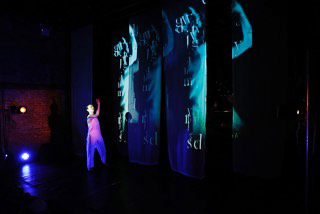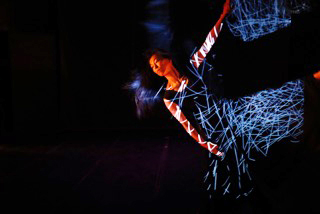Dance: In The Box 2; Miki Orihara and Friends at LA MAMA
By Dawn Lille
arttimesjournal July 26, 2017
 In The Box @ La MaMa, NYC | June 30-July 2, 2017- dancer/choreographer Miki Orihara (Photo by Yoji Kawada) |
In The Box 2, a Japanese production, was seen at La Mama June 30 – July 2. An almost hidden program note said it explored the paradox of “where technology meets the body,” inspired by Schrodinger’s cat. It featured Miki Orihara as dancer and choreographer, Senri Oe as composer and jazz musician and Hiroyuki Nishiyama a.k.a. nissy as director and producer.
The cat in the box was a thought experiment devised in 1935 by the Austrian physicist Erwin Schrodinger in which he proposed a theory related to quantum mechanics. If a cat is placed in a sealed box with a flask containing poison and one atom breaks down, causing the flask to open, is the cat dead or alive? The observer does not know, in what is defined scientifically as a “superposition” of states, until the box is opened.
The experiment was meant to show the conflict between what quantum theory defines as true about matter on the microscopic level and what the human eye observes to be true. The paradox here is that there is no outcome unless it is observed.
 dancer/choreographer Miki Orihara (Photo by Yoji Kawada) |
Miki Orihara, born and trained in Japan, joined the Martha Graham Company in 1987 and has received a Bessie award for her performances. She has also danced with many other companies, including Twyla Tharp and Robert Wilson. She teaches internationally and has presented her solo choreography in New York and Tokyo. Nishiyama divided this production into ten segments. In a later interview she said that she, as choreographer, put her own concepts into many of them.
The stage was covered with a gauze curtain draped at an angle from the back of the performing area up toward the audience and attached to the ceiling. As one entered there were different lighting and sound effects playing off this decorated cloth.
When the work officially began Orihara could be seen curled up on the stage, lighted through this veiled covering. Her slow, almost voluptuous movements on the floor were meant to represent birth. A later section began with four other dancers walking simple straight lines, mostly around the perimeter of the stage. When she eventually joined them all eyes went to her focused, zen-like pedestrian steps. The others became passing traffic. She said that, to her, this was Times Square, where loneliness pervades ‘midst all the movement. People are alone together.
One part, in which she was dressed in white pants and shirt, was her homage to the dancer/choreographer Trisha Brown, who died recently. Here, the projections were spontaneously created by Yasuhiro Chida, seated in the audience with his computer. But none of this was obvious without a program note.
 composer/pianist Senri Oe (Photo by Yoji Kawada) |
Orihara is a beautiful dancer and fairly new choreographer, whose creative talents are just beginning to come forth. Oe’s jazz is often lyrical, but in this instance it did not seem particularly relevant to what was observed on stage and some loud piercing sounds were not pleasant. His solos alone drew attention, but their point of reference remained unknown. Nishiyama, whose concept this was, and who created many of the visuals, needs to make very clear the definitive idea guiding the production.
How many in the audience even knew about the cat in the box? What were the ten sections? Additionally, there was insufficient coordination between the three medias. They need additional time to experiment and work together in order to produce a work with substantial form and a point of view. Orihara’s interest in how technology affects the body and its movement requires more exploration. The possibilities are endless and the talent is there. I’m not sure about the cat.
dawnlille@aol.com
